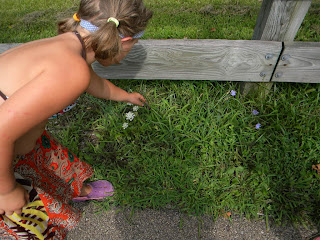This is the time of year when I am thinking a lot about how we do things here at home. The truth is that I don't think of it as "how we school" but how we go about our days. This is just the time of year when I try to pry the bits and pieces out of the whole and file them away by label: science, mathematics, language arts, social sciences, etc...We opt to have our homeschooling evaluated by a certified teacher, rather than submit standardized test scores, and though the woman who performs our evaluation is understanding of how we do things, it is kind of a challenge to me to try and make lists of where the things we do fit into those categories.
Black Rat Snake
Today's excursion to the bike path illuminated the way we do science around here. We make a lot of observations....
We pause and watch and wonder...
Why do butterflies eat poo???
We research...they need nutrients that they can't get from nectar - like nitrogen and phosphorous.
We notice how the recent rains have affected our river, and the amount of trash the increased flow is able to carry...We notice that some plants are very successful at taking over this new "island": poison ivy, virginia creeper, and jewelweed for starters.
We talk about the plants we see. We count their petals...
We name them....in the picture above Eliza is able to name eight different plants without any help: chicory, Queen Anne's Lace, plantain - two varieties, clover, dandelion, horsetail fern and poison ivy. We continue down the path - grape vine, sumac, jewelweed...I don't think it is really important for kids to know the names of things just for the sake of knowing them, but it is something I am interested in and Eliza seems to be interested in that as well. It also makes the natural world more familiar to her.
We "I spy" their parts...I spy...something curly! ...something blue! ...something green (she says with a grin...what isn't green here??)...something a bug has been chomping...
And then the girls have a GREAT idea for a new mystery about a plant that has lost its leaves, or maybe a plant that acts like a vampire and drinks blood, a mystery that is solved by two sisters, sort of like the Hardy Boys...but that would be getting into Language Arts, not science...right?
:: :: :: ::
I compile lists of books, games and resources we have used and will use to support all of this exploration. Here are a few of our most often-used resources:
A variety of regional field guides on wildflowers, insects, amphibians, reptiles and birds (our favorites are Wildflowers Of Tennessee, The Ohio Valley and the Southern Appalachians and National Wildlife Federation Field Guide to Insects and Spiders of North America , as well as the series of field guides put out by the Ohio Department of Natural Resources)
Let's-Read-and-Find-Out Science books - good for introducing a topic
Wildcraft Board Game
Snap Circuits Jr - this is a new activity for us, and it is so much fun! Eliza is able to use it herself with minimal guidance and Anika often asks to get it out as well.
David Attenborough documentaries...we love this naturalist, and it is amazing how much the girls remember about the mating habits of the jumping spider or the hunting techniques of various insects from his Life in the Undergrowth, which I think might be our favorite.
In addition to this, our cooking leads us to various experiments, we have made body maps, outlining our skeletons and introducing systems of the body, and we check out books from the library that delve into geology, physics, biology, weather systems...Our library hosted a number of workshops this summer, two of which dealt with the water cycle and water ecology - our brains are brimming with thoughts about this world and how things work! Isn't that what science is about?












3 comments:
Nature study is an important part of science, for sure!
This is a great post showing how science - particularly natural science - can be part of daily living.
Snap Circuits and field guides are huge favorites over here, as is David Attenborough. I was lucky enough to pick up a couple of his companion books at a thrift store and they have been big "flip through" volumes for my son, who is a budding entomologist.
That is exactly what science is all about! Curiosity, touching, feeling, looking, wondering, trying, learning...
Post a Comment